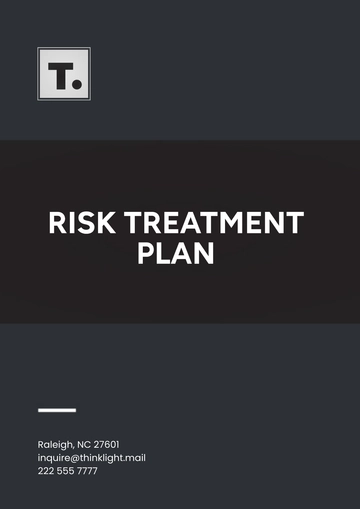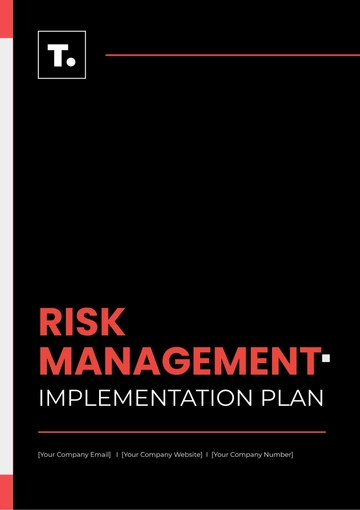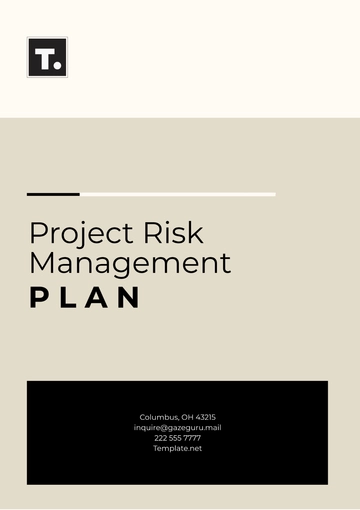Free Real Estate Legal Risk Management Plan

A. Risk Identification
In order to proactively address potential legal challenges within our real estate operations, it is imperative to implement robust risk identification methods. Our focus will be on recognizing and assessing risks associated with various facets of real estate transactions and management. This includes, but is not limited to, property acquisition, leasing agreements, financing arrangements, development projects, construction activities, compliance with zoning laws, environmental regulations, and property management practices.
To ensure comprehensive risk identification, we will employ a multi-faceted approach that leverages industry expertise, expert consultation, and thorough auditing processes. Our team will continuously monitor industry trends, legal developments, and regulatory changes to stay ahead of emerging risks. Additionally, we will engage legal counsel and subject matter experts to provide insights and guidance on complex legal issues.
Furthermore, regular audits and assessments will be conducted across all aspects of our real estate operations to identify potential vulnerabilities and areas of concern. These audits will encompass thorough reviews of contracts, leases, financial documents, property records, and compliance documentation.
By diligently identifying and assessing potential legal risks, we can effectively mitigate their impact and protect the interests of our company and stakeholders. Our proactive approach to risk identification ensures that we remain compliant with relevant laws and regulations while safeguarding our reputation and financial well-being.
B. Risk Assessment
Once potential risks have been identified, it is imperative to assess them systematically to gauge their potential impact and likelihood of occurrence. This critical step allows us to prioritize our risk management efforts and allocate resources effectively.
Our risk assessment framework entails evaluating each identified risk based on its severity and probability, categorizing them into high, medium, or low risk categories. Risks with significant potential impact and high likelihood of occurrence will be classified as high risk and will receive immediate attention and mitigation efforts. Conversely, risks with lower impact and probability may be classified as medium or low risk, allowing us to prioritize resources accordingly. Through this structured risk assessment process, we can ensure that our risk management strategies are aligned with our business objectives and regulatory requirements, thus mitigating potential legal liabilities effectively.
The following represents a basic framework for categorizing these risks:
Risk | Severity | Probability |
|---|---|---|
Risk 1 | High | Medium |
Risk 2 | Medium | Low |
Risk 3 | Low | High |
Risk 4 | High | High |
Risk 5 | Low | Low |
C. Mitigation Strategies
Developing and implementing gentle and effective mitigation strategies is a crucial dimension of risk management. Such strategies may include but are not limited to:
Adopting specific contractual provisions
Obtaining necessary insurance
Conducting comprehensive due diligence
Strict adherence to regulations
Pursuing legal consultation promptly when needed
In instances where complex legal issues arise, we are prepared to promptly seek legal consultation from qualified professionals to address challenges effectively and minimize legal exposure.
By implementing these proactive mitigation strategies, we aim to safeguard our company's interests, protect our stakeholders, and uphold our commitment to ethical and responsible business practices.
D. Compliance Procedures
Compliance with regulatory requirements is paramount to the success and sustainability of our real estate operations. To ensure adherence to pertinent laws and regulations, we have established comprehensive compliance procedures encompassing various key areas of legal compliance.
Fair Housing Laws Compliance |
We are committed to upholding fair housing laws to prevent discrimination in housing practices. Our policies and procedures are designed to promote equal access to housing opportunities for all individuals, regardless of race, color, religion, national origin, sex, familial status, or disability. |
Landlord-Tenant Laws Adherence |
Proper understanding and compliance with landlord-tenant laws are essential to maintain harmonious relationships with tenants and uphold their rights. We provide ongoing training and education to our staff to ensure compliance with lease agreements, eviction procedures, security deposit regulations, and other relevant laws governing landlord-tenant relationships. |
Property Disclosure Laws Compliance |
Transparency and integrity in property transactions are paramount. We strictly adhere to property disclosure laws, ensuring that all material facts and defects pertaining to a property are disclosed to buyers or tenants in accordance with legal requirements. |
Environmental Conservation Laws Compliance |
Environmental sustainability is a core value of our organization. We comply with environmental conservation laws and regulations to minimize our environmental impact and promote sustainable development practices in our real estate projects. |
Zoning Laws and Building Codes Compliance |
Compliance with zoning laws and building codes is essential to ensure the safety, integrity, and legality of our real estate developments. Our projects undergo rigorous review and approval processes to ensure compliance with zoning regulations, land use restrictions, and building codes enforced by local authorities. |
To foster a culture of compliance within our organization, we provide regular training seminars, workshops, and certifications for all personnel, from frontline staff to senior management. These educational initiatives ensure that every member of our team is equipped with the knowledge and understanding necessary to fulfill their compliance obligations effectively.
By adhering to stringent compliance procedures and staying abreast of evolving legal requirements, we uphold the highest standards of ethical conduct and legal compliance in all aspects of our real estate operations.
E. Contract Management
Effective contract management plays a pivotal role in mitigating legal risks within our real estate operations. Contracts serve as the foundation for all transactions and interactions with stakeholders, requiring meticulous attention to detail and proactive management throughout their lifecycle. Our focus on draft reviewing, negotiating, and enforcing contracts ensures clarity, fairness, and compliance with legal requirements, thereby safeguarding our interests and fostering positive relationships with all parties involved.
Aspect | Description |
|---|---|
Drafting | Meticulous drafting of contracts tailored to specific transactional requirements and legal considerations. |
Reviewing | Comprehensive review of contracts to identify potential risks, ambiguities, and areas for improvement or clarification. |
Negotiating | Skillful negotiation of contract terms and conditions to achieve favorable outcomes while minimizing legal exposure. |
Enforcement | Vigorous enforcement of contractual obligations and remedies in the event of breaches or disputes. |
Stakeholders | Engaging with various stakeholders, including clients, tenants, vendors, contractors, and lenders, to ensure alignment and agreement on contract terms. |
F. Dispute Resolution
In the event of disputes arising within our real estate operations, it is imperative to have a structured and efficient dispute resolution mechanism in place. Our approach prioritizes amicable resolution through negotiation, mediation, or arbitration, with litigation as a last resort. The following process outlines our approach to resolving disputes effectively and preserving positive relationships.

Identification: Promptly identify and acknowledge the existence of the dispute.
Assessment: Evaluate the nature, severity, and potential impact of the dispute.
Communication: Open lines of communication with all parties involved to facilitate dialogue and understanding.
Negotiation: Engage in constructive negotiation to seek mutually acceptable resolutions.
Mediation/Arbitration: If necessary, pursue mediation or arbitration with the assistance of impartial third-party mediators or arbitrators.
Litigation: Consider litigation as a last resort if all other methods fail to resolve the dispute satisfactorily, prioritizing efficient resolution while minimizing legal costs and reputational risks.
G. Monitoring and Review
The Real Estate Legal Risk Management Plan is a dynamic framework that necessitates ongoing monitoring, evaluation, and refinement to ensure its effectiveness and adaptability in an ever-evolving legal and operational landscape. This section outlines the structured approach we will undertake to continually assess and enhance our risk management practices.
1. Regular Monitoring
Routine Assessments: Conduct periodic assessments of key risk indicators and performance metrics to gauge the efficacy of risk management measures.
Incident Tracking: Implement a system for tracking and documenting legal incidents, complaints, or breaches to identify recurring patterns or emerging trends.
2. Evaluation of Effectiveness
Performance Reviews: Conduct comprehensive reviews of the Real Estate Legal Risk Management Plan to evaluate its effectiveness in mitigating legal risks and achieving organizational objectives.
Stakeholder Feedback: Solicit feedback from stakeholders, including employees, clients, tenants, and legal advisors, to gather insights on the plan's strengths and areas for improvement.
3. Relevance and Adaptability
Legal Updates: Stay abreast of changes in laws, regulations, and industry standards relevant to real estate operations, and incorporate necessary updates into the risk management plan.
Operational Changes: Assess the impact of organizational changes, such as expansions, acquisitions, or diversifications, on legal risks and adjust risk management strategies accordingly.
4. Documentation and Reporting
Maintaining Records: Maintain detailed records of risk management activities, including assessments, reviews, and updates, to ensure accountability and transparency.
Reporting Mechanisms: Establish mechanisms for reporting significant legal incidents or emerging risks to senior management and relevant stakeholders in a timely manner.
H. Training and Development
Employee training and development play a pivotal role in strengthening our risk management practices and ensuring compliance with regulatory requirements within our real estate operations. This section outlines our commitment to providing comprehensive training programs tailored to equip our team members with the knowledge and skills necessary to identify, mitigate, and manage legal risks effectively.
1. Risk Awareness Training
Identification of Potential Risks: Provide training sessions to educate employees on recognizing and assessing potential legal risks across various aspects of real estate transactions and operations.
Understanding Regulatory Compliance: Offer training modules focused on familiarizing employees with pertinent laws, regulations, and industry standards governing real estate activities.
2. Regulation Compliance Training
Fair Housing Laws: Conduct training sessions to ensure employees understand and adhere to fair housing laws to prevent discrimination in housing practices.
Landlord-Tenant Laws: Provide training on landlord-tenant laws to ensure compliance with lease agreements, eviction procedures, and tenant rights.
3. Dispute Resolution Training
Negotiation Skills Development: Offer training workshops to enhance employees' negotiation skills, enabling them to resolve disputes amicably and minimize legal exposure.
Mediation and Arbitration Techniques: Provide guidance on mediation and arbitration techniques to facilitate efficient resolution of conflicts outside the courtroom.
4. Mitigation Measures Training
Contract Management: Educate employees on the importance of effective contract management and the implementation of mitigation strategies, such as specific contractual provisions and insurance coverage.
Due Diligence Procedures: Train employees on conducting thorough due diligence in real estate transactions to identify and mitigate potential risks.
I. Crisis Management
Even with thorough planning, real estate companies must be prepared to effectively manage unexpected crises that may arise. This section outlines our approach to crisis management, emphasizing swift response, effective communication, and proactive measures to mitigate the impact of crises on our operations and reputation.
Response Protocols:
In the event of a crisis, we have established clear response protocols outlining roles, responsibilities, and escalation procedures. This includes designating a crisis management team responsible for coordinating response efforts, communicating with stakeholders, and implementing predetermined action plans to address the crisis promptly.
Communication Strategies:
Timely and transparent communication is paramount during a crisis. We have developed communication strategies to ensure accurate and consistent messaging to internal and external stakeholders, including employees, clients, tenants, investors, regulatory authorities, and the media. These strategies prioritize maintaining trust, minimizing speculation, and providing updates on the situation as it unfolds.
Crisis Preparedness Drills:
Regular crisis preparedness drills and simulations are conducted to test the effectiveness of our response protocols and communication strategies. These drills provide valuable opportunities for team members to familiarize themselves with their roles and responsibilities, identify areas for improvement, and enhance overall preparedness for potential crises.
J. Documenting and Record Keeping
Effective documentation and record-keeping practices are essential pillars of our Risk Management Plan, enabling us to capture and preserve critical information vital for risk identification, dispute resolution, and compliance audits. This section delineates our commitment to maintaining comprehensive and accurate documentation, leveraging advanced data storage solutions to enhance security and efficiency.
1. Documentation Standards
Standardized Formats: Establish standardized formats and templates for documenting various aspects of risk management activities, including risk assessments, mitigation strategies, compliance procedures, and crisis response protocols.
Version Control: Implement robust version control mechanisms to track revisions and updates to documentation, ensuring the integrity and accuracy of information over time.
2. Record-Keeping Procedures
Centralized Repository: Maintain a centralized repository for storing and organizing documents, accessible to authorized personnel for reference and retrieval as needed.
Retention Policies: Develop and enforce retention policies outlining the duration for which different types of records must be retained, in compliance with legal and regulatory requirements.
3. Data Storage Solutions
Secure Cloud Storage: Utilize secure cloud storage platforms with encryption and access controls to safeguard sensitive information from unauthorized access or data breaches.
Document Management Systems: Implement document management systems with features for categorization, searchability, and audit trails to streamline document storage, retrieval, and tracking processes.
By prioritizing comprehensive documentation and record-keeping practices supported by advanced data storage solutions, we not only enhance the effectiveness of our Risk Management Plan but also reinforce our commitment to transparency, accountability, and regulatory compliance. This ensures that we are well-equipped to navigate legal complexities, mitigate risks, and protect the interests of our stakeholders in the dynamic landscape of real estate operations.
- 100% Customizable, free editor
- Access 1 Million+ Templates, photo’s & graphics
- Download or share as a template
- Click and replace photos, graphics, text, backgrounds
- Resize, crop, AI write & more
- Access advanced editor
Mitigate potential legal challenges with the Real Estate Legal Risk Management Plan Template from Template.net. This editable and customizable template outlines strategies for identifying, assessing, and addressing legal risks associated with real estate operations. Editable in our Ai Editor Tool, it's essential for safeguarding your real estate investments, ensuring compliance with laws and regulations, and maintaining a secure business environment.
You may also like
- Finance Plan
- Construction Plan
- Sales Plan
- Development Plan
- Career Plan
- Budget Plan
- HR Plan
- Education Plan
- Transition Plan
- Work Plan
- Training Plan
- Communication Plan
- Operation Plan
- Health And Safety Plan
- Strategy Plan
- Professional Development Plan
- Advertising Plan
- Risk Management Plan
- Restaurant Plan
- School Plan
- Nursing Home Patient Care Plan
- Nursing Care Plan
- Plan Event
- Startup Plan
- Social Media Plan
- Staffing Plan
- Annual Plan
- Content Plan
- Payment Plan
- Implementation Plan
- Hotel Plan
- Workout Plan
- Accounting Plan
- Campaign Plan
- Essay Plan
- 30 60 90 Day Plan
- Research Plan
- Recruitment Plan
- 90 Day Plan
- Quarterly Plan
- Emergency Plan
- 5 Year Plan
- Gym Plan
- Personal Plan
- IT and Software Plan
- Treatment Plan
- Real Estate Plan
- Law Firm Plan
- Healthcare Plan
- Improvement Plan
- Media Plan
- 5 Year Business Plan
- Learning Plan
- Marketing Campaign Plan
- Travel Agency Plan
- Cleaning Services Plan
- Interior Design Plan
- Performance Plan
- PR Plan
- Birth Plan
- Life Plan
- SEO Plan
- Disaster Recovery Plan
- Continuity Plan
- Launch Plan
- Legal Plan
- Behavior Plan
- Performance Improvement Plan
- Salon Plan
- Security Plan
- Security Management Plan
- Employee Development Plan
- Quality Plan
- Service Improvement Plan
- Growth Plan
- Incident Response Plan
- Basketball Plan
- Emergency Action Plan
- Product Launch Plan
- Spa Plan
- Employee Training Plan
- Data Analysis Plan
- Employee Action Plan
- Territory Plan
- Audit Plan
- Classroom Plan
- Activity Plan
- Parenting Plan
- Care Plan
- Project Execution Plan
- Exercise Plan
- Internship Plan
- Software Development Plan
- Continuous Improvement Plan
- Leave Plan
- 90 Day Sales Plan
- Advertising Agency Plan
- Employee Transition Plan
- Smart Action Plan
- Workplace Safety Plan
- Behavior Change Plan
- Contingency Plan
- Continuity of Operations Plan
- Health Plan
- Quality Control Plan
- Self Plan
- Sports Development Plan
- Change Management Plan
- Ecommerce Plan
- Personal Financial Plan
- Process Improvement Plan
- 30-60-90 Day Sales Plan
- Crisis Management Plan
- Engagement Plan
- Execution Plan
- Pandemic Plan
- Quality Assurance Plan
- Service Continuity Plan
- Agile Project Plan
- Fundraising Plan
- Job Transition Plan
- Asset Maintenance Plan
- Maintenance Plan
- Software Test Plan
- Staff Training and Development Plan
- 3 Year Plan
- Brand Activation Plan
- Release Plan
- Resource Plan
- Risk Mitigation Plan
- Teacher Plan
- 30 60 90 Day Plan for New Manager
- Food Safety Plan
- Food Truck Plan
- Hiring Plan
- Quality Management Plan
- Wellness Plan
- Behavior Intervention Plan
- Bonus Plan
- Investment Plan
- Maternity Leave Plan
- Pandemic Response Plan
- Succession Planning
- Coaching Plan
- Configuration Management Plan
- Remote Work Plan
- Self Care Plan
- Teaching Plan
- 100-Day Plan
- HACCP Plan
- Student Plan
- Sustainability Plan
- 30 60 90 Day Plan for Interview
- Access Plan
- Site Specific Safety Plan





























